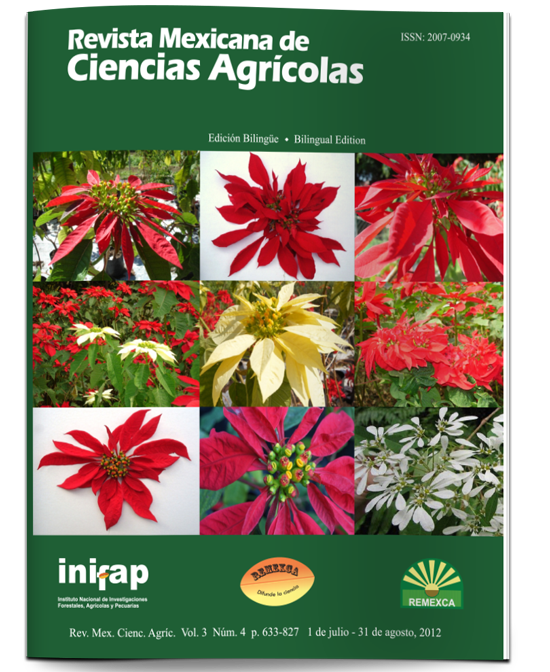Growth and, proline and carbohydrate content of bean seedlings subjected to drought stress
DOI:
https://doi.org/10.29312/remexca.v3i4.1425Keywords:
Phaseolus vulgaris L., carbohydrates, proline, compatible solutesAbstract
Drought stress in the highlands of Mexico is a limiting factor in bean yields. In this work we studied the physiological responses (growth) and biochemical (soluble carbohydrates and proline) in the radicle of seedlings resistant beans, Pinto Villa and, susceptible to drought Bayo Madero, both of Durango race, in order to identify quick features to measure their reliability for selection of resistance to drought stress. The radicle of the seedlings were subjected to four moisture potentials: -2.07, -0.52, -0.27 megapascals (MPa) and a control -0.16 MPa. For determining the soluble carbohydrates and proline, the potential -0.16 Mpa was removed, since it caused the hypocotyl rot at the junction with the cotyledon, in this case the potential of -0.27 was considered as control. The radicle of both varieties had greater length in the treatments with less stress. In the most critical potential, -2.07 MPa, Pinto Villa, accumulated more proline and sucrose than Bayo Madero, while starch levels were quite similar. Highly significant correlation was observed between the elongation of the radicle with the accumulation of proline, glucose and fructose (r= 0.99 respectively). The accumulation of compatible solutes (glucose, fructose, sucrose and proline) in the radicle developed under conditions of stress, favors its growth in early stages of development. Compatible solutes are suitable as biochemical indicators for selection of varieties resistant to moisture stress during the first three days of germination.
Downloads
Downloads
Published
How to Cite
Issue
Section
License
The authors who publish in Revista Mexicana de Ciencias Agrícolas accept the following conditions:
In accordance with copyright laws, Revista Mexicana de Ciencias Agrícolas recognizes and respects the authors’ moral right and ownership of property rights which will be transferred to the journal for dissemination in open access. Invariably, all the authors have to sign a letter of transfer of property rights and of originality of the article to Instituto Nacional de Investigaciones Forestales, Agrícolas y Pecuarias (INIFAP) [National Institute of Forestry, Agricultural and Livestock Research]. The author(s) must pay a fee for the reception of articles before proceeding to editorial review.
All the texts published by Revista Mexicana de Ciencias Agrícolas —with no exception— are distributed under a Creative Commons License Attribution-NonCommercial 4.0 International (CC BY-NC 4.0), which allows third parties to use the publication as long as the work’s authorship and its first publication in this journal are mentioned.
The author(s) can enter into independent and additional contractual agreements for the nonexclusive distribution of the version of the article published in Revista Mexicana de Ciencias Agrícolas (for example include it into an institutional repository or publish it in a book) as long as it is clearly and explicitly indicated that the work was published for the first time in Revista Mexicana de Ciencias Agrícolas.
For all the above, the authors shall send the Letter-transfer of Property Rights for the first publication duly filled in and signed by the author(s). This form must be sent as a PDF file to: revista_atm@yahoo.com.mx; cienciasagricola@inifap.gob.mx; remexca2017@gmail.
This work is licensed under a Creative Commons Attribution-Noncommercial 4.0 International license.



